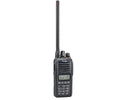
The Differences Between Digital and Analog Radios
, by Joseph Gabriel, 1 min reading time

, by Joseph Gabriel, 1 min reading time

Two-way radios have entered the digital era. Because we’re in the transitional period from analog to digital, many businesses must pick between the tried-and-true originals and the new, unknown models. Let’s take a look at the differences between digital and analog radios to help you decide what kind of radio system best suits your needs.
Analog and digital radios use Very High Frequency (VHF) or Ultra High Frequency (UHF) radio waves. The signal has to be sent via frequency modulation for analog radios. This encodes a voice signal within the carrier wave. The voice signal is received and demodulated by another radio to relay the intended message, creating a representation or an “analogy” of the voice, hence the radio’s name.
The primary challenge with analog radios is that the signal gets weaker and weaker the longer it travels, and objects—trees or walls—can block it, making it difficult to communicate at long range without the help of equipment like repeaters.
Digital radios take a different approach. Rather than encoding voice signals to create a simulacrum of your voice, it is translated into a binary format, with each one or zero representing two distinct amplitudes. Analog signals are continuous, but digital signals are transmitted as non-continuous block segments. This delivers clear voice quality to the limits of the radio’s range.
Digital radios are generally much more versatile and powerful than analog radios. They have a greater range without the assistance of equipment like repeaters and can integrate into analog systems. Now that you know the differences between digital and analog radios, you don’t have to worry about upgrading your entire organization if you transition to digital radios.
We understand new technology may be tricky to understand. Luckily, the great brands you already rely on, such as industrial-favorite Icom two-way radios, are at the forefront of innovative radios as you make the switch.